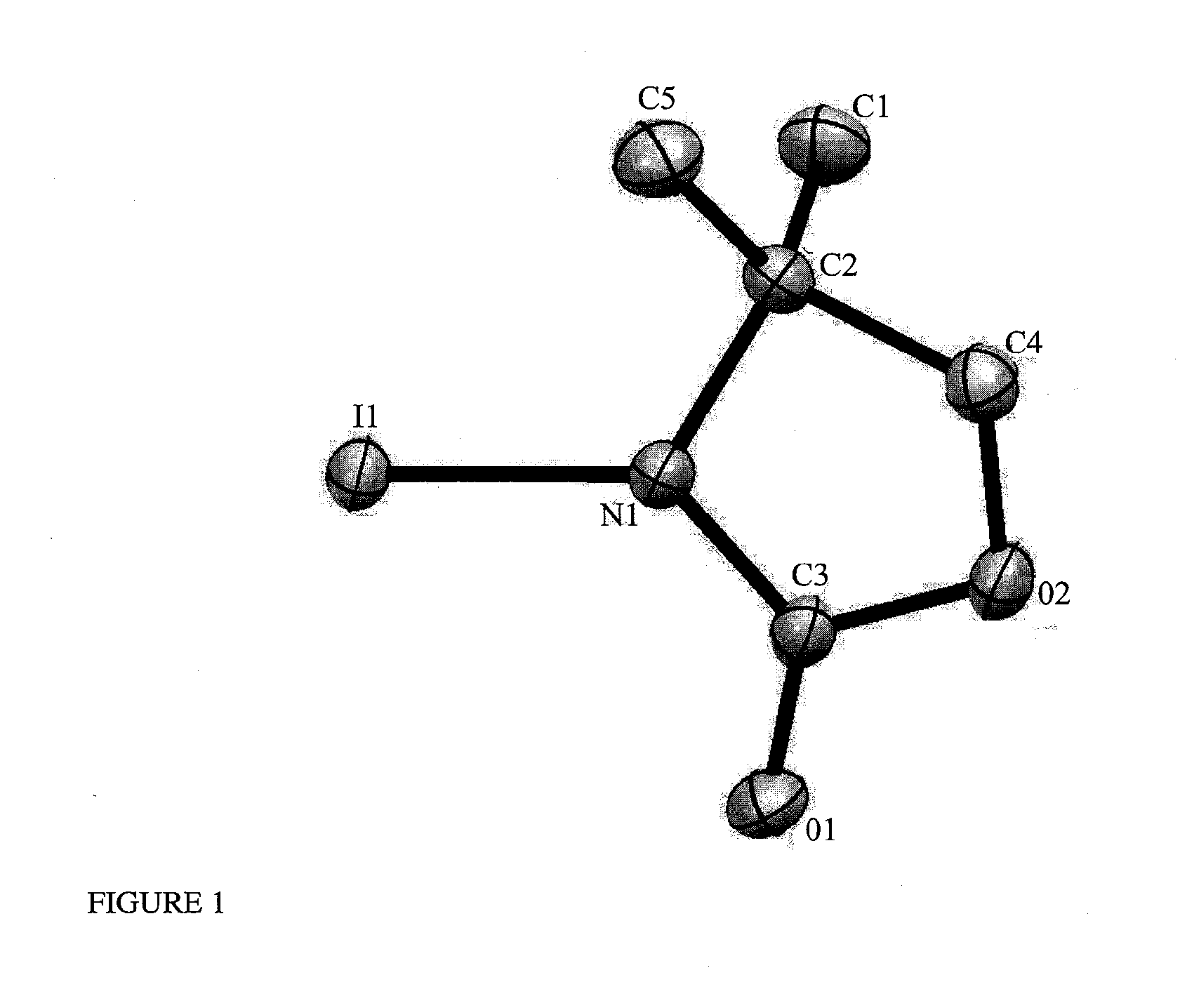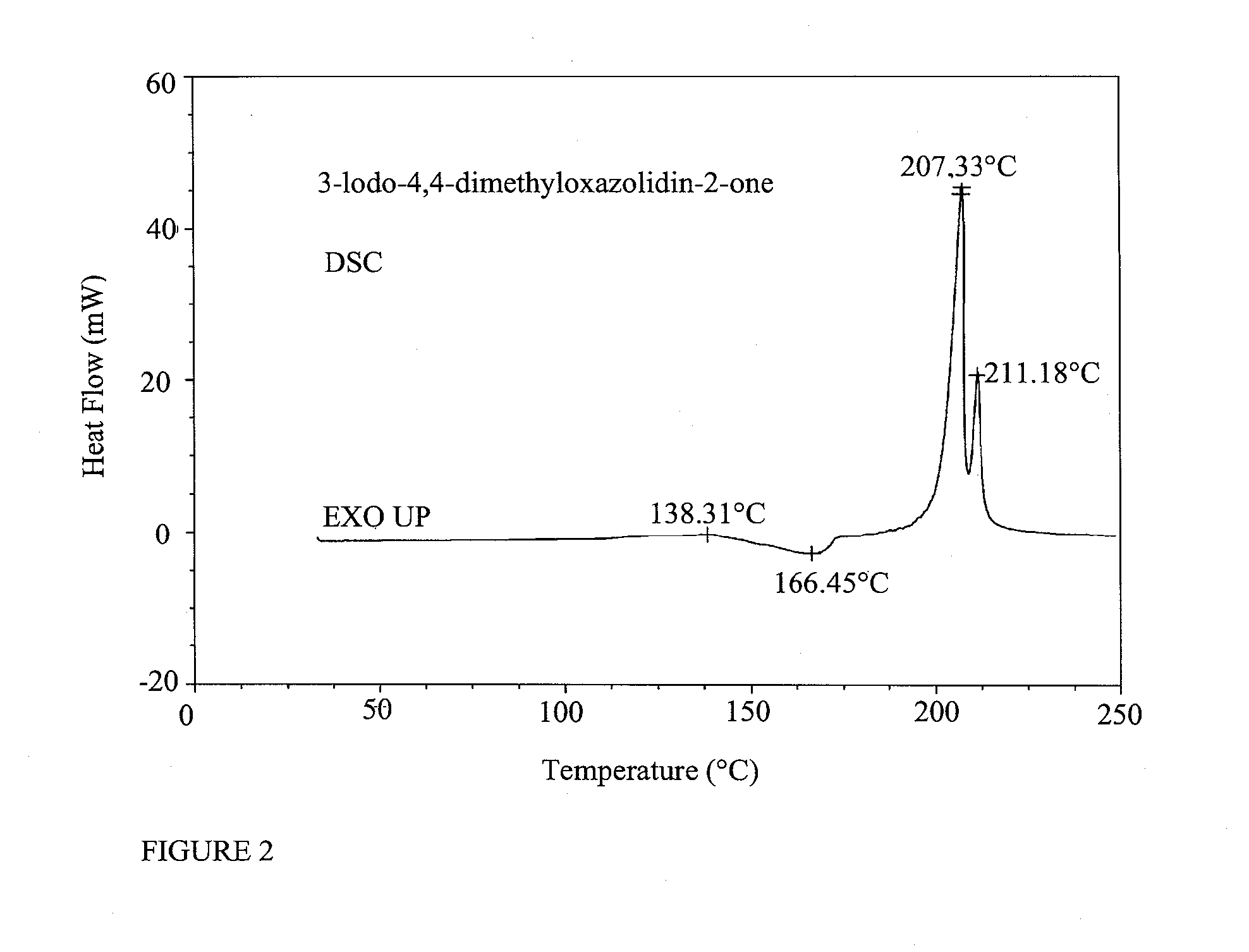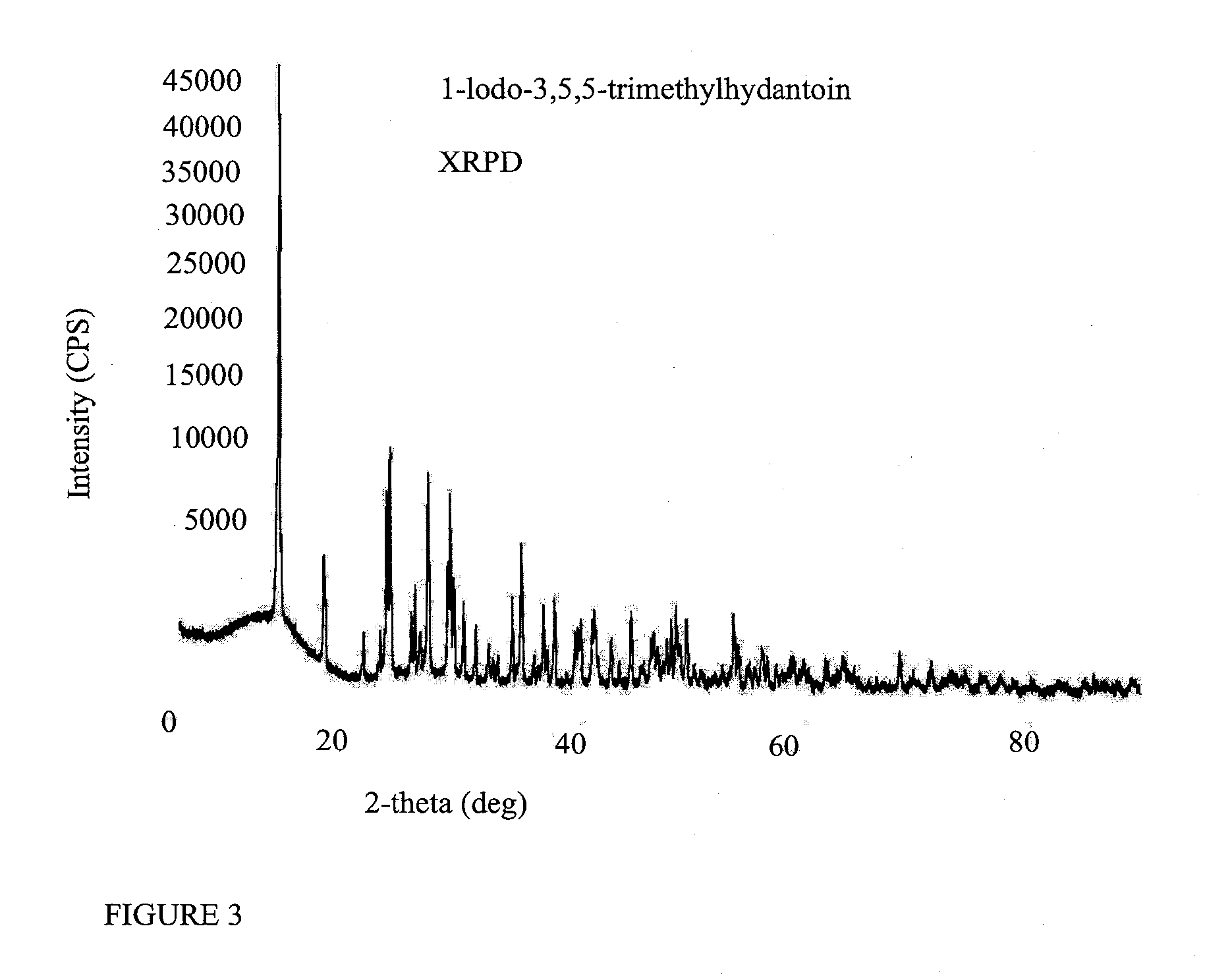Process for the preparation of n-iodoamides
a niodoamide and niodosuccinimide technology, applied in the field of new stable crystalline niodoamides, can solve the problems of limited use of nisac, limited scope of use of nisac, and search for a new generation of stable niodoamide suitable for radical and electrophilic iodination
- Summary
- Abstract
- Description
- Claims
- Application Information
AI Technical Summary
Benefits of technology
Problems solved by technology
Method used
Image
Examples
example 1
Preparation of DMO and 3,5,5-TMH
Preparation of 4,4-dimethyloxazolidin-2-one (DMO)
[0265]
[0266]A mixture of 2-amino-2-methyl-1-propanol (10.0 g, 112 mmole) and urea (13.5 g, 224 mmole) was heated for 1 h at 170-180° C., for 1 h at 210-220° C., cold to rt and dissolved in water (50 mL). The solution was extracted with DCM (5×50 mL). The combined extracts were dried over Na2SO4, filtered and concentrated in vacuo to afford 10.3 g (80%) of 4,4-dimethyloxazolidin-2-one. 1H NMR (CDCl3): δ 6.13 (br s, 1H, NH), 4.07 (s, 2H, CH2), 1.32 (s, 6H, 2 CH3) ppm. 13C NMR (CDCl3) δ 159.4, 77.1, 55.4, 27.7 ppm.
Preparation of 3,5,5-trimethylhydantoin (3,5,5-TMH)
[0267]
[0268]A mixture of 5,5-dimethylhydantoin (12.8 g, 100 mmol), (MeO)2SO2 (12.0 g, 95 mmol), K2CO3 (20.7 g, 150 mmol) and acetone (200 mL) was stirred for 16 h at rt and concentrated in vacuo. Aqueous solution of the residue was extracted with DCM (3×50 mL). Combine organic extracts were washed with water (50 mL), dried over Na2SO4, filtered a...
example 2
Crystal of 3,5,5-trimethylhydantoin (3,5,5-TMH)
[0271]
[0272]3,5,5-Trimethylhydantoin (0.2 g) was dissolved in acetone (2 mL). The solvents were slowly evaporated from the mixture at rt on the air to give 0.60×0.114×0.093 mm crystal of 3,5,5-trimethylhydantoin. The crystalline 3,5,5-trimethylhydantoinis characterized by a single x-ray crystallographic analysis at 200(2) K, which yields crystal parameters (Table 2.1), atomic positions of all atoms relative to the origin of the unit cell (Table 2.2) , bond lengths (Table 2.3), and bond angles (Table 2.4).
TABLE 2.1Crystal parameters of 3,5,5-trimethylhydantoinFormulaC6H10N2O2Formula weight (amu)142.16Crystal systemMonoclinicSpace groupP 21 / nCell dimensionsa (Å)9.3210(3)b (Å)8.2470(3)c (Å)9.5290(3)α = γ (°)90β (°)96.993(2)V (Å3)727.05(4)Z (molecules / units cell)4Density (g / cm3)1.299
[0273]The unit cell dimension is defined by three parameters: length of the sides of the cell, relative angles of sides to each other and the volume of the cell...
example 3
Recovery of Amides from Aqueous Solution
[0275]A mixture of amide (weight of amide (W): 0.2-0.5 g), water (20-100 mL) and water immiscible organic solvent (the same volume as water) was stirred at 25° C. for 0.5 h. The organic layer was thoroughly separated, dried over Na2SO4, filtered and concentrated in vacuo to recover the amide. Distribution coefficient K was calculated according to the formula K=Wo / W−Wo, where Wo is weight of the recovered amide in g. Distribution coefficients of 3,5,5-trimethylhydantoin (3,5,5-TMH), 4,4-dimethyloxazolidin-2-one (DMO), 5,5-dimethylhydantoin (DMH) and succinimide in hexane, benzene, CCl4 and DCM are shown in Table 3.1.
TABLE 3.1Distribution coefficients (K) of amides in organic solvents at25° C.solventsuccinimideDMH3,5,5-TMHDMOhexane0.1≦0.1≦0.1≦0.1≦PhH0.1≦0.1≦0.1≦0.1≦CCl40.1≦0.1≦0.1≦0.1≦DCM0.1≦0.1≦1.60.5
[0276]The larger the value of distribution coefficient, the more amide will be transferred to the solvent with each extraction, and the fewer port...
PUM
| Property | Measurement | Unit |
|---|---|---|
| electrophilic | aaaaa | aaaaa |
| structure | aaaaa | aaaaa |
| water soluble | aaaaa | aaaaa |
Abstract
Description
Claims
Application Information
 Login to View More
Login to View More - R&D
- Intellectual Property
- Life Sciences
- Materials
- Tech Scout
- Unparalleled Data Quality
- Higher Quality Content
- 60% Fewer Hallucinations
Browse by: Latest US Patents, China's latest patents, Technical Efficacy Thesaurus, Application Domain, Technology Topic, Popular Technical Reports.
© 2025 PatSnap. All rights reserved.Legal|Privacy policy|Modern Slavery Act Transparency Statement|Sitemap|About US| Contact US: help@patsnap.com



